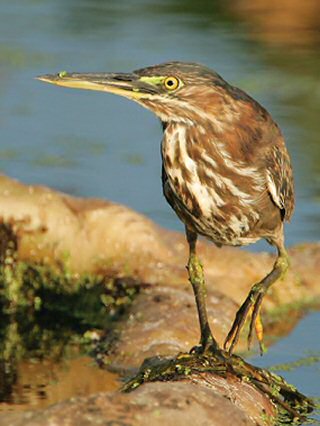313 Hudson Avenue, Tenafly, NJ 07670
Phone: (201) 568-6093
www.tenaflynaturecenter.org
Borough of Tenafly, leased by Tenafly Nature Center
From the driveway proceed straight onto Van Nostrand Avenue. At the second traffic light turn Right onto Grand Avenue/Rt. 93. After 1 mile Grand Avenue becomes Engle Street. After a total of 5.8 miles Engle Street ends at a “T” intersection, turn Right onto Hudson Avenue. Follow Hudson Avenue up the hill and into
driveway of Tenafly Nature Center. Map
Rockland Coaches’ Bus Line Nos. 9/9A/9T/9TA run along Route 9W. The closest stop to the Center is at Montammy Drive, a private golf course. Walk south on the shoulder of 9W, turn Right onto Hudson Avenue, and then straight through to the Center. Walking distance less than 1 mile.
Tenafly Nature Center is a wildflower watcher’s dream, especially the Red Trail in spring. The delicate spring beauty has grass-like leaves and white, pink-lined petals and may be found alongside the tiny white umbels of the dwarf ginseng. The trout lily and purple violet are scattered throughout the forest. As these flowers begin to fade, Canada mayflower, mayapple, Solomon’s-seal and wild geranium emerge, along with the show-stopping pink lady’s-slipper.
Have a close up look at the resident Barred Owl (please do not hoot) and the Red-Tailed Hawk right outside the Interpretive Center. Both birds are permanently injured and cannot be released into the wild. Also, the Backyard Habitat gardens attract a variety of
butterflies including pipevine swallowtail, tiger swallowtail, clouded sulphur and red admiral. They are usually too busy nectaring to mind
nearby observers.
 |
| Green Heron | Scott Elowitz |
| |
| | Tenafly Nature Center and the Lost Brook Preserve occupy approximately 380 contiguous wooded acres. This wildlife haven offers seven miles of trails, Pfister’s Pond, and a buttonbush swamp, all surrounded by a mixed hardwood oak forest. Visit the Nature Center’s Interpretive building where you can get a map of the trails, find out about special programs, discuss your experience with professional environmental educators and also enjoy their
natural history exhibits.
Don’t miss Pfister’s Pond, where there is always something happening no matter the season. From waterfowl to dragonflies to shorebirds to frogs and turtles, a stop at the pond is a must. Follow the Yellow Trail to a buttonbush swamp and explore the 50-foot dock, an ideal vantage point from which to survey the pond. On the opposite side of the pond you will find the Dr. Joseph DeFilippi Shelter, a great place to take a break and quietly observe nature around you.
Winter is a quiet time but it is not devoid of wildlife. The Red-tailed Hawk can be seen and often heard flying overhead, while Great Horned Owl may call at dusk, establishing territory. Look for the active winter seed-eaters, such as Black-capped Chickadee, Tufted Titmouse, Dark-eyed Junco and White-throated Sparrow foraging in the leaves. Make sure to check out the pond toward the end of February for the return of Mallard and Wood Duck.
March is the best month for waterfowl on Pfister’s Pond. In early morning and then again in the evening look for Mallard, Wood and Ring-necked Ducks along with Hooded Merganser. Perhaps you will find the first Eastern Phoebe of the season in the buttonbush swamp. Listen for spring peepers and wood frogs around the pond and vernal pools. Eastern painted turtles can be seen basking on logs around the pond and with a sharp eye you might spot a garter or ring-necked snake. March to early April, spotted salamanders breed in the bog opposite the pond. April is a good month for Pied-billed Grebe, Green-winged Teal and Great Blue Heron. The white blossoms of the shadbush can be found along the DeFilippi boardwalk. When migration is in full swing in May, 20 or more species of warbler can be found, along with Scarlet Tanager and Rose-breasted Grosbeak.
Stay on the trails, poison ivy is widespread throughout the woods, but only 15% of the trail edges contain it. Approximately 50 species of birds remain on the property during the summer, including Baltimore Oriole, Rose-breasted Grosbeak, Red-eyed Vireo and the Eastern Wood-Pewee. Patient and lucky observers might glimpse the resident Pileated Woodpecker on an old snag. Check Pfister’s Pond for a Green Heron stalking prey, or a Belted Kingfisher diving for food. Arrange to be at the pond around dusk for a bullfrog serenade.
Although fall does not arrive until the 3rd week in September, the fall migration is in full swing weeks earlier. North to northwest winds provide ideal conditions for birds, butterflies and dragonflies, so keep an eye on the weather and try to plan accordingly. The white blooms of the turtlehead wildflower can be found on the DeFilippi Trail and red cardinal flower near the old dam on the Little-Chism Trail. At Pfister’s Pond, waterfowl fly in to rest for the night, including Green-winged Teal, Wood and American Black Ducks, Mallard, Canada Goose and Pied-billed Grebe. Little brown and big brown bats will be feasting on 500-1,000 insects an hour before they depart for their hibernaculum, usually in caves. This is another great spot to observe migrating raptors and fall warblers.
|